Glass Laser Engraving Guide: Tips and Tricks
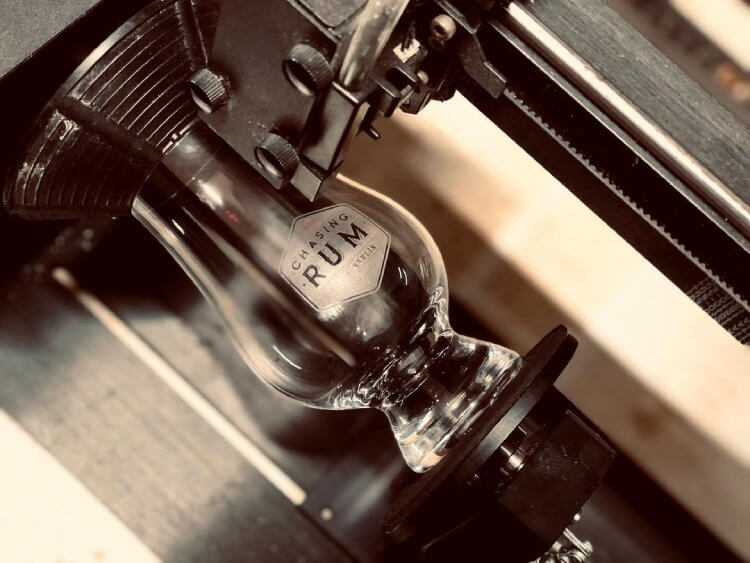
IG:@bodindesign
El grabado láser de vidrio es una técnica de vanguardia reconocida por su capacidad para crear diseños intrincados y duraderos en superficies de vidrio. Con la creciente accesibilidad de los equipos de grabado láser y un creciente interés en creaciones personalizadas, el grabado láser de vidrio se ha vuelto más popular que nunca. Los entusiastas del bricolaje pueden crear fácilmente diseños únicos para personalizar cristalería, espejos o paneles decorativos. En los espacios arquitectónicos, el arte en vidrio grabado con láser encuentra su lugar en una variedad de características elegantes y funcionales.
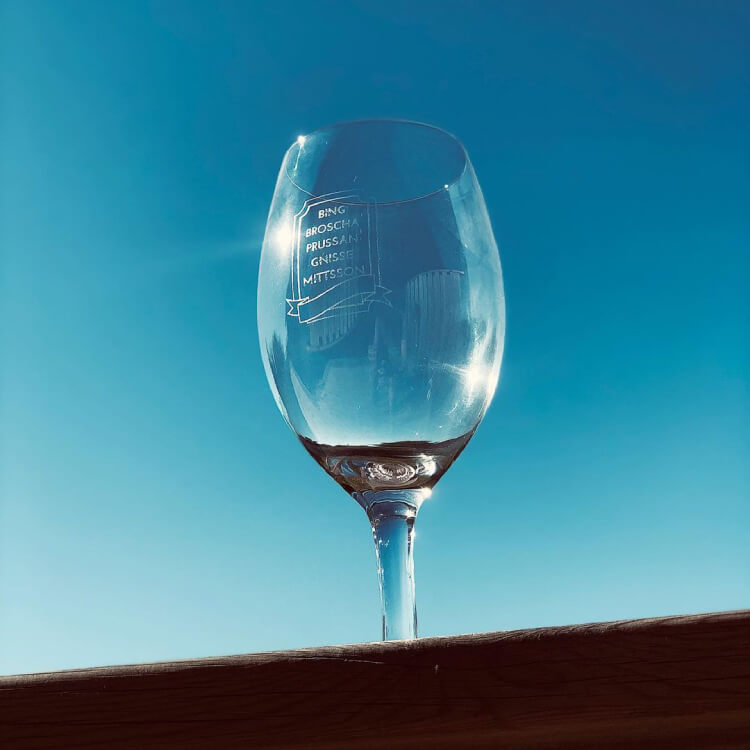
IG:@bodindesign
¿Qué es el grabado láser en vidrio?
Definición y principios básicos
El grabado láser en vidrio es una técnica de precisión que utiliza rayos láser enfocados para grabar diseños, patrones o texto en superficies de vidrio. El proceso implica dirigir un láser de alta intensidad sobre el material de vidrio, lo que provoca un calentamiento localizado. El calor generado por el láser vaporiza la superficie o crea microfisuras, lo que permite la creación de grabados muy detallados sin comprometer la integridad estructural del vidrio.
Los principios fundamentales del grabado láser dependen de dos factores clave: el tipo de láser utilizado y los ajustes aplicados durante el proceso de grabado. Los láseres de CO2 se utilizan comúnmente para este propósito, ya que son muy eficaces en materiales no metálicos como el vidrio. El control preciso de la potencia puede crear efectos de grabado refinados, lo que permite diseños intrincados que van desde logotipos simples hasta imágenes detalladas.
Tipos de láseres que se utilizan comúnmente para el grabado de vidrio
Los láseres de CO2 suelen ser más adecuados que los láseres de fibra para el grabado de vidrio debido a su compatibilidad con el material de vidrio. Los láseres de CO2 funcionan a una longitud de onda de 10,6 micrones, que es bien absorbida por el vidrio. Esto permite un grabado altamente eficiente. La longitud de onda de un láser de fibra es de 1,06 micrones, que no es fácilmente absorbida por el vidrio.
Al ajustar parámetros como la potencia, la velocidad y las opciones de tramado, los láseres de CO2 se pueden utilizar para grabar una variedad de artículos de vidrio, incluidos vasos, botellas y artículos decorativos, y crear diferentes efectos en su superficie, como un efecto esmerilado.
En qué se diferencia el grabado láser de los métodos de grabado tradicionales
El grabado láser ofrece varias ventajas sobre los métodos de grabado mecánicos tradicionales:
Proceso sin contacto:
El láser no toca físicamente el vidrio, lo que reduce el riesgo de rotura o daño. Esto también permite grabar en artículos delicados o de forma irregular. ¡Así que puede grabar sin preocuparse por arruinar sus valiosas piezas!
Precisión y detalle:
La tecnología láser ofrece precisión, un tamaño de punto fino y detalles que los métodos mecánicos no pueden igualar. También garantiza una calidad constante en grandes tiradas de producción.
Velocidad:
El grabado láser suele ser un proceso más rápido, especialmente para diseños intrincados. Es una solución ideal para la producción de gran volumen.
Versatilidad:
El proceso permite una transición perfecta entre varios diseños sin cambiar las herramientas. El sistema controlado por software permite realizar ajustes rápidos y sin esfuerzo, lo que garantiza la eficiencia y la precisión.
Relación coste-beneficio:
La tecnología láser elimina la necesidad de reemplazar constantemente los equipos y los suministros, lo que permite ahorrar dinero a largo plazo. También produce resultados de gran volumen y alta calidad rápidamente, lo que ahorra tiempo y dinero a empresas de todos los tamaños.
Impacto medioambiental:
El grabado láser evita el uso de productos químicos agresivos y tiene un menor impacto medioambiental en comparación con los métodos de grabado tradicionales. Además, los avances en la tecnología láser garantizan una alineación precisa y minimizan el desperdicio de material.
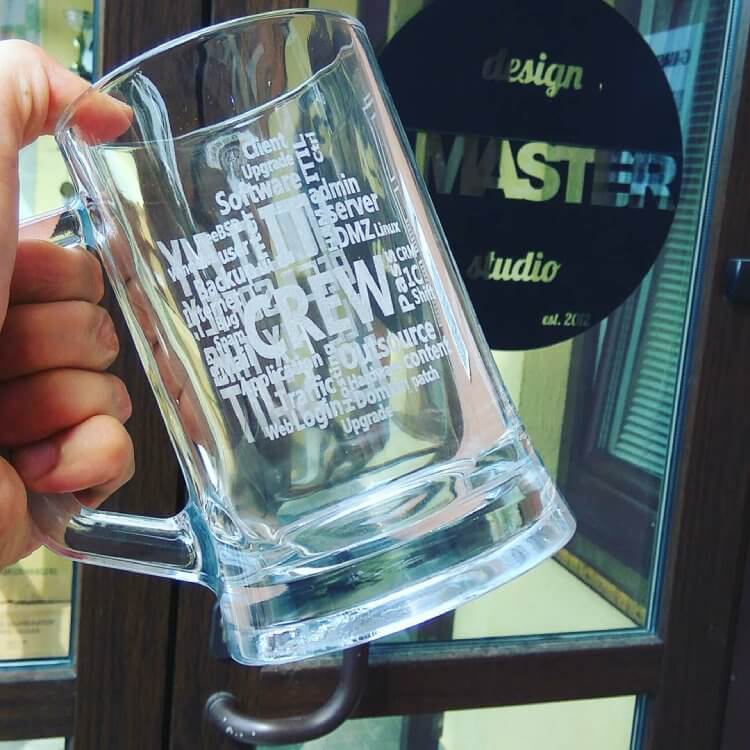
IG:@gravirovka_kiev
El proceso de grabado láser de vidrio
El grabado láser de vidrio es un proceso intrigante que utiliza un rayo láser finamente ajustado para grabar diseños, patrones o texto detallados en la superficie. Aquí tienes una guía fácil de seguir de los pasos necesarios:
- Creación del diseño: empieza por crear o elegir el diseño para grabar usando un software de diseño gráfico.
- Preparación del vidrio: limpia bien el vidrio con acetona o alcohol.o eliminar suciedad, polvo o aceites. Esto garantiza que el grabado sea suave y preciso.
- Configuración del láser: Coloque el vidrio en la mesa de trabajo de la máquina y cargue el archivo de grabado en la interfaz. Ajuste los parámetros clave (potencia, velocidad y resolución) según el tipo de vidrio y el efecto deseado.
- Grabado: Realice una prueba de potencia para ajustar la configuración de la máquina. Una vez que todo esté ajustado, comience a grabar. El láser creará microfracturas o eliminará con cuidado la capa superior del vidrio, lo que dará como resultado el diseño grabado.
- Limpieza: una vez que se complete el grabado, lave el revestimiento o los residuos con agua o un limpiador adecuado para revelar el diseño terminado.
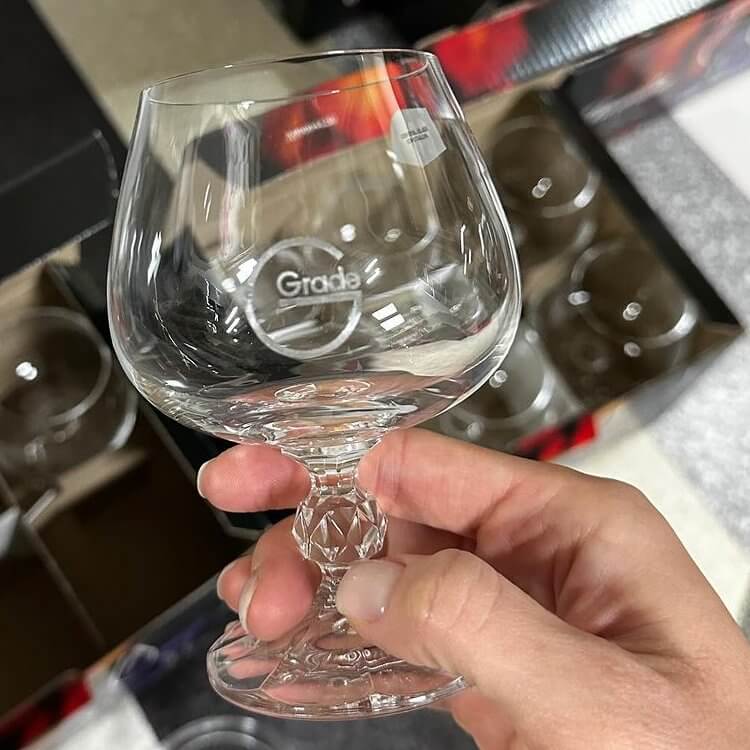
IG:@gravirovka_kiev
Consejos y trucos para un grabado exitoso en vidrio
Use gráficos vectoriales: para obtener mejores resultados, opte por diseños vectoriales en lugar de escala de grises, ya que el vidrio No se maneja bien el sombreado y puede generar resultados inconsistentes.
Use una toalla de papel húmeda: si es necesario, coloque una toalla de papel húmeda sobre el área que se va a grabar. Este simple paso garantiza una superficie de grabado suave, asegurando resultados nítidos, claros y blancos brillantes.
Use un accesorio giratorio: use una herramienta giratoria para objetos cilíndricos como copas de vino para lograr grabados uniformes y precisos.
Refleje la imagen: si graba desde la parte posterior del vidrio, refleje la imagen en el software para asegurarse de que la imagen sea correcta cuando se ve desde el frente.
El proceso de grabado láser es flexible y se puede adaptar según la complejidad del diseño específico, los tipos de vidrio y las necesidades de aplicación. Optimice el equilibrio de potencia, velocidad y frecuencia del láser para que cada proyecto tenga éxito en el grabado láser de vidrio.
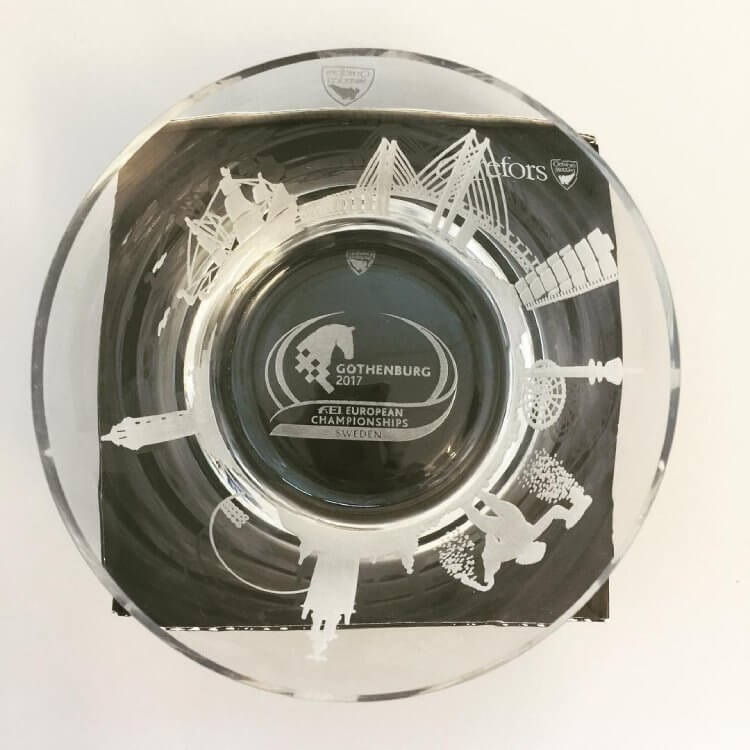
IG:@vasaboden
Aplicaciones del grabado láser de vidrio
El grabado láser de vidrio es una técnica versátil que se utiliza en diversas aplicaciones, entre ellas:
Regalos personalizados: grabe nombres, mensajes o diseños en cristalería, trofeos y recuerdos, convirtiéndolos en regalos únicos y memorables para ocasiones especiales.
Corporativo Marcas: Cree logotipos o textos personalizados en artículos de vidrio, como premios, letreros de oficina o productos promocionales, y añada un toque profesional a sus esfuerzos de marca.
Diseño de interiores: Grabe patrones, texturas o ilustraciones intrincadas en paneles de vidrio, espejos o ventanas para realzar las características arquitectónicas y la decoración de interiores.
Aplicaciones industriales: Marcar componentes de vidrio con números de serie, códigos de barras o información de seguridad garantiza la trazabilidad y el cumplimiento en las industrias manufactureras.
Proyectos de arte y manualidades: Use el grabado láser para crear ilustraciones detalladas en superficies de vidrio y añada un nivel profesional de precisión a los artículos hechos a mano.
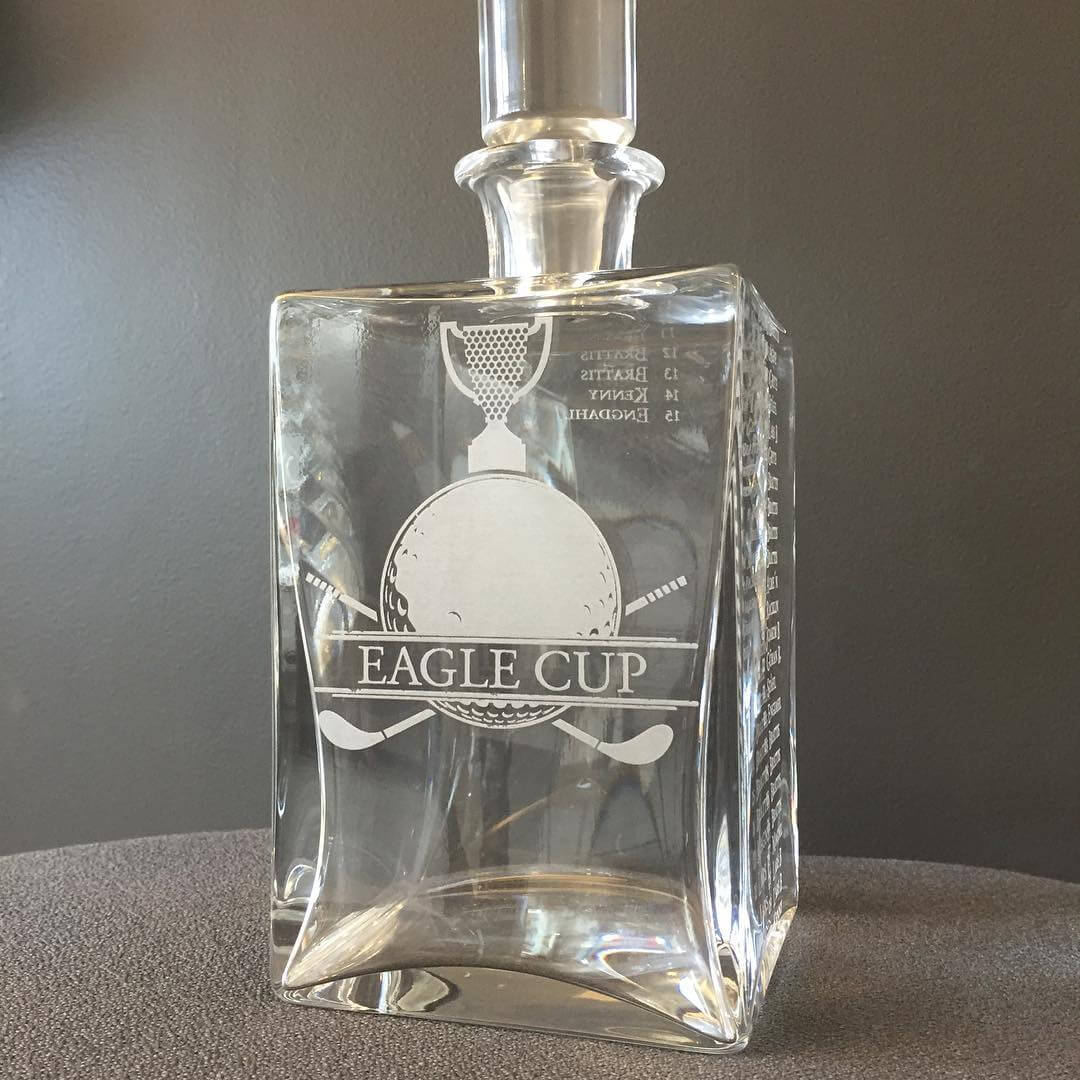
IG:@vasaboden
Cómo elegir el grabador láser adecuado
¿Está buscando una máquina láser para grabar vidrio? Estos son los factores clave que debe tener en cuenta al elegir una:
Tipo de láser: los láseres de CO2 son perfectos para grabar vidrio, ya que crean un acabado esmerilado sorprendente. Pueden grabar fácilmente logotipos personalizados y diseños intrincados en casi cualquier artículo de vidrio. Explore los grabadores láser y Cortadora láser, que ofrece una variedad de especificaciones para satisfacer sus necesidades de grabado de vidrio.
Potencia del láser: Para el grabado de vidrio, se recomienda un láser con al menos 30 vatios, ya que una potencia mayor acelera el proceso y mejora la eficiencia.
Tamaño de la mesa: Asegúrese de que el área de trabajo se alinee con las dimensiones de sus piezas de vidrio. Si bien los artículos más pequeños, como la cristalería, requieren una mesa compacta, los proyectos más grandes pueden necesitar un área de trabajo más grande para acomodar el diseño.
Accesorio giratorio: Un accesorio giratorio es crucial para grabar artículos de vidrio cilíndricos, como copas de vino, botellas y jarrones. Gira suavemente el vidrio durante el grabado, lo que garantiza un diseño uniforme en todas partes. Además, se adapta fácilmente a varios tamaños de vidrio sin la necesidad de mediciones precisas.
